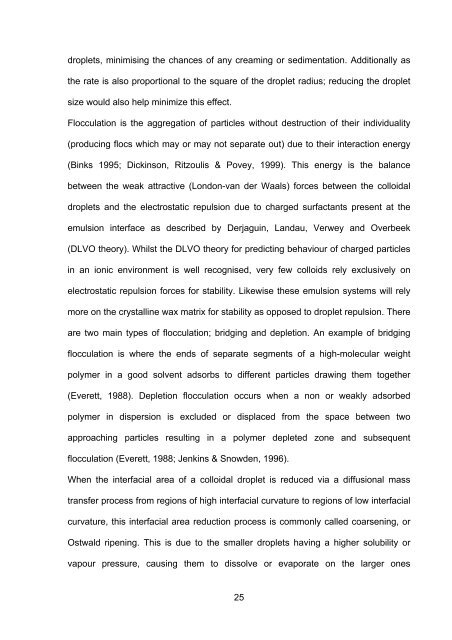Stabilisation of water-in-oil emulsions to improve - eTheses ...
Stabilisation of water-in-oil emulsions to improve - eTheses ...
Stabilisation of water-in-oil emulsions to improve - eTheses ...
Create successful ePaper yourself
Turn your PDF publications into a flip-book with our unique Google optimized e-Paper software.
droplets, m<strong>in</strong>imis<strong>in</strong>g the chances <strong>of</strong> any cream<strong>in</strong>g or sedimentation. Additionally as<br />
the rate is also proportional <strong>to</strong> the square <strong>of</strong> the droplet radius; reduc<strong>in</strong>g the droplet<br />
size would also help m<strong>in</strong>imize this effect.<br />
Flocculation is the aggregation <strong>of</strong> particles without destruction <strong>of</strong> their <strong>in</strong>dividuality<br />
(produc<strong>in</strong>g flocs which may or may not separate out) due <strong>to</strong> their <strong>in</strong>teraction energy<br />
(B<strong>in</strong>ks 1995; Dick<strong>in</strong>son, Ritzoulis & Povey, 1999). This energy is the balance<br />
between the weak attractive (London-van der Waals) forces between the colloidal<br />
droplets and the electrostatic repulsion due <strong>to</strong> charged surfactants present at the<br />
emulsion <strong>in</strong>terface as described by Derjagu<strong>in</strong>, Landau, Verwey and Overbeek<br />
(DLVO theory). Whilst the DLVO theory for predict<strong>in</strong>g behaviour <strong>of</strong> charged particles<br />
<strong>in</strong> an ionic environment is well recognised, very few colloids rely exclusively on<br />
electrostatic repulsion forces for stability. Likewise these emulsion systems will rely<br />
more on the crystall<strong>in</strong>e wax matrix for stability as opposed <strong>to</strong> droplet repulsion. There<br />
are two ma<strong>in</strong> types <strong>of</strong> flocculation; bridg<strong>in</strong>g and depletion. An example <strong>of</strong> bridg<strong>in</strong>g<br />
flocculation is where the ends <strong>of</strong> separate segments <strong>of</strong> a high-molecular weight<br />
polymer <strong>in</strong> a good solvent adsorbs <strong>to</strong> different particles draw<strong>in</strong>g them <strong>to</strong>gether<br />
(Everett, 1988). Depletion flocculation occurs when a non or weakly adsorbed<br />
polymer <strong>in</strong> dispersion is excluded or displaced from the space between two<br />
approach<strong>in</strong>g particles result<strong>in</strong>g <strong>in</strong> a polymer depleted zone and subsequent<br />
flocculation (Everett, 1988; Jenk<strong>in</strong>s & Snowden, 1996).<br />
When the <strong>in</strong>terfacial area <strong>of</strong> a colloidal droplet is reduced via a diffusional mass<br />
transfer process from regions <strong>of</strong> high <strong>in</strong>terfacial curvature <strong>to</strong> regions <strong>of</strong> low <strong>in</strong>terfacial<br />
curvature, this <strong>in</strong>terfacial area reduction process is commonly called coarsen<strong>in</strong>g, or<br />
Ostwald ripen<strong>in</strong>g. This is due <strong>to</strong> the smaller droplets hav<strong>in</strong>g a higher solubility or<br />
vapour pressure, caus<strong>in</strong>g them <strong>to</strong> dissolve or evaporate on the larger ones<br />
25
















